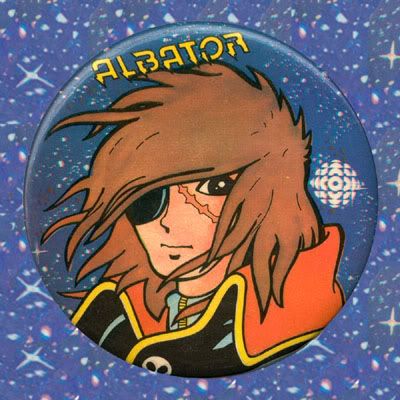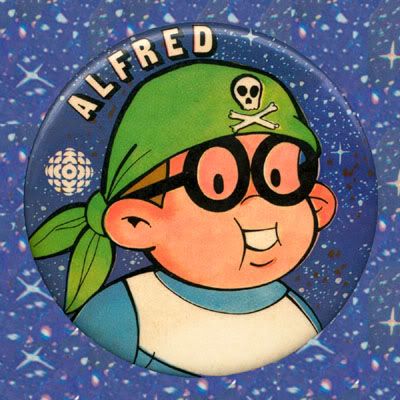At Anime North a few weeks ago my wife spotted something groovy in the dealers room. No, not glomping crossdressing furry cosplayers – but something that was actually related to Japanese cartoons! Namely, a set of buttons from Albator.

You know, Albator! The French language version of Toei’s 1978 Captain Harlock series, broadcast to the Francophone world in the late 1970s. Albator, whose name was changed from “Captain Harlock” because, as the story goes, the French localizers were afraid children would confuse the character with “Captain Haddock” from the popular Belgian comic Tintin. Because the characters are so much alike! There isn't a similar story to explain why every other character in Captain Harlock got his or her name changed, nor why all the music was thrown out in favor of vastly inferior replacements.


At any rate the buttons are pretty cool. Not just because Tadashi Daiba – sorry, “Ramis” - is clearly missing an eye, or the general sloppy fan art vibe of the artwork, but mostly for the 70s era CBC logo plastered onto the images. Albator was broadcast on the French-language CBC – sorry, “Radio-Canada Television”- starting in 1979, and along with other French-language anime hits like Goldorak, Candy Candy, and Le Roi Leo, gave the Francophone Canadian anime fan a distinct advantage over the Anglophone Canucks, who were forced to make do with Star Blazers and Force Five on Buffalo UHF stations.


You might notice that one of these characters is not like the others. Sure, Captain Future, the '78 Toei series based on the pulp series by Edmond Hamilton, was popular in Europe, where he was known as "Capitane Flam". However, how a button of Captain Future’s girlfriend “beautiful Joan Randall” wound up with some Albator badges is anybody’s guess. You know those Japanese cartoons, they all look the same. And the character's slight name change only proves the Electric Company's hypothesis that a Joan can become a “Johan” merely by adding our good friend “silent h”.

You know, Albator! The French language version of Toei’s 1978 Captain Harlock series, broadcast to the Francophone world in the late 1970s. Albator, whose name was changed from “Captain Harlock” because, as the story goes, the French localizers were afraid children would confuse the character with “Captain Haddock” from the popular Belgian comic Tintin. Because the characters are so much alike! There isn't a similar story to explain why every other character in Captain Harlock got his or her name changed, nor why all the music was thrown out in favor of vastly inferior replacements.


At any rate the buttons are pretty cool. Not just because Tadashi Daiba – sorry, “Ramis” - is clearly missing an eye, or the general sloppy fan art vibe of the artwork, but mostly for the 70s era CBC logo plastered onto the images. Albator was broadcast on the French-language CBC – sorry, “Radio-Canada Television”- starting in 1979, and along with other French-language anime hits like Goldorak, Candy Candy, and Le Roi Leo, gave the Francophone Canadian anime fan a distinct advantage over the Anglophone Canucks, who were forced to make do with Star Blazers and Force Five on Buffalo UHF stations.


You might notice that one of these characters is not like the others. Sure, Captain Future, the '78 Toei series based on the pulp series by Edmond Hamilton, was popular in Europe, where he was known as "Capitane Flam". However, how a button of Captain Future’s girlfriend “beautiful Joan Randall” wound up with some Albator badges is anybody’s guess. You know those Japanese cartoons, they all look the same. And the character's slight name change only proves the Electric Company's hypothesis that a Joan can become a “Johan” merely by adding our good friend “silent h”.